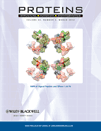Structural studies of a signal peptide in complex with signal peptidase I cytoplasmic domain: The stabilizing effect of membrane-mimetics on the acquired fold
Abstract
A protein destined for export from the cell cytoplasm is synthesized as a preprotein with an amino-terminal signal peptide. In Escherichia coli, typically signal peptides that guide preproteins into the SecYEG protein conduction channel are subsequently removed by signal peptidase I. To understand the mechanism of this critical step, we have assessed the conformation of the signal peptide when bound to signal peptidase by solution nuclear magnetic resonance. We employed a soluble form of signal peptidase, which laks the two transmembrane domains (SPase I Δ2-75), and the E. coli alkaline phosphatase signal peptide. Using a transferred NOE approach, we found clear evidence of a weak peptide-enzyme complex formation. The peptide adopts a U-turn shape originating from the proline residues within the primary sequence that is stabilized by its interaction with the peptidase and leaves key residues of the cleavage region exposed for proteolysis. In dodecylphosphocholine (DPC) micelles the signal peptide also adopts a U-turn shape comparable with that observed in association with the enzyme. In both environments this conformation is stabilized by the signal peptide phenylalanine side chain-interaction with enzyme or lipid mimetic. Moreover, in the presence of DPC, the N-terminal core region residues of the peptide adopt a helical motif and based on PRE (paramagnetic relaxation enhancement) experiments are shown to be buried within the membrane. Taken together, this is consistent with proteolysis of the preprotein occurring while the signal peptide remains in the bilayer and the enzyme active site functioning at the membrane surface. Proteins 2011. © 2012 Wiley Periodicals, Inc.




